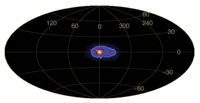Galactic positron annihilation: not a signal of dark matter?
22 July 2009
INTEGRAL's all-sky map of the 511 keV line emission has been used to conclude that dark matter is not the origin of galactic positron annihilation, contrary to what had been assumed in past years. In a recent paper published in Physical Review Letters Richard Lingenfelter and colleagues argue that no exotic sources are required to explain the spatial and spectral features observed by INTEGRAL.Since its detection almost 40 years ago on a balloon experiment, the 511 keV line emission from the centre of the Milky Way has been a constant source of theoretical and observational attention.
The line emission and the associated positronium continuum have always appeared to be spatially extended, coinciding with the galactic bulge, the halo, and the inner galactic disk.
That there should be abundant production of positrons in the Galaxy has long been known: the beta decay of radionuclei 56Ni, 44Ti, and 26Al in supernova ejecta and winds of Wolf Rayet stars is well understood, and can easily account for the complete supply of positrons required to account for the observed gamma-ray flux.
 |
|
INTEGRAL's map of the Galaxy at 511 keV. Credit: ESA/ INTEGRAL/ MPE (G. Weidenspointner et al.) |
Recently, the analysis of more than 50 million seconds of data collected by INTEGRAL produced a detailed map of the 511 keV emission from the centre of our Galaxy. The increase in spectral and spatial resolution delivered by the INTEGRAL instruments (significantly above that of previous gamma-ray detectors) reveals that the emission is strongly peaked towards the centre of the Galaxy, with an asymmetry along the galactic disk (see Weidenspointner et al 2008a,b). Additionally, the ratio of the luminosity of bulge to that of the disk is found to be 4 times higher than that of the Galactic supernovae, the main source of the positrons.
For many years the underlying assumption in the interpretation of the 511-keV data has been that the positrons annihilate close to their sources because the conditions they encounter are such that they cannot propagate for very long distances. Based on this assumption, the expectation is that the distribution of the radiation will closely match the distribution of the sources.
The large discrepancy between the distribution of the assumed sources and that of the radiation brought to light by INTEGRAL has therefore triggered a search for new objects able to produce positrons in a region of the Galaxy devoid of any known sources of positrons. Exotic dark matter objects like new axinos, Q balls, millicharged fermions, and many more have been suggested as possible new sources of positrons in the bulge.
In a paper published in the 17 July issue of Physical Review Letters Richard Lingenfelter and his colleagues James Higdon and Richard Rothschild restore order in the discussion. The main point made by the authors is that it is incorrect to assume that positrons cannot propagate over large distances, which was the central motivation behind the dark matter hypothesis. Just like cosmic ray electrons of the same energy in fact, positrons can travel unhindered over kiloparsec-scale distances because, as the authors show, their interaction with the magnetic fluctuations across most of the Galaxy is too weak to affect them significantly.
Having removed the obstacle to the propagation of the positrons, the authors are now able to explain the observed flux ratio in terms of classical sources of positrons. Additionally, allowing for the propagation of positrons makes it possible to explain another feature of the radiation, namely the ratio between the 511 line flux and the positronium continuum, an aspect neglected by the dark matter solutions to the problem. In an accompanying paper published in the Astrophysical Journal, the authors show that the observed asymmetry can be explained by the asymmetry of the Galactic spiral arm as seen from the Solar System, finally putting to rest the need to invoke an exotic explanation for the experimental observations.
Reference publication
Lingenfelter, R.E., Higdon, J.C. Rothschild, R.E., "Is There a Dark Matter Signal in the Galactic Positron Annihilation Radiation?", Physical Review Letters, Volume 103, Issue 3, 031301, 2009. DOI:10.1103/PhysRevLett.103.031301
Related publications
Higdon, J. C., Lingenfelter, R. E., Rothschild, R. E., "The Galactic Positron Annihilation Radiation and the Propagation of Positrons in the Interstellar Medium", The Astrophysical Journal, Volume 698, Issue 1, pp. 350-379, 2009. DOI:10.1088/0004-637X/698/1/350
Weidenspointner, G., et al., "An asymmetric distribution of positrons in the Galactic disk revealed by gamma-rays", Nature, 451, 159-162, 2008a. DOI:10.1038/nature06490
Weidenspointner, G., et al., "Positron astronomy with SPI/INTEGRAL", New Astronomy Reviews, Volume 52, Issues 7-10, pp 454-456, 2008b. DOI:10.1016/j.newar.2008.06.019

